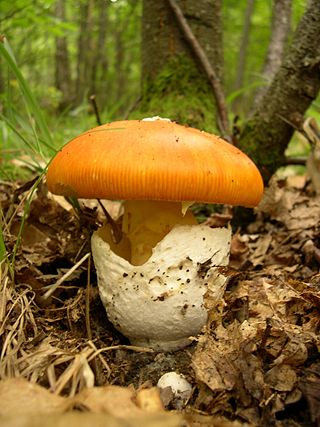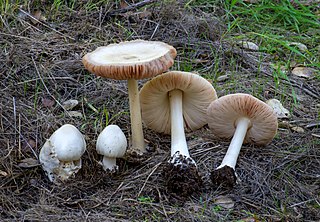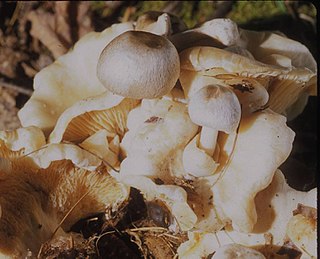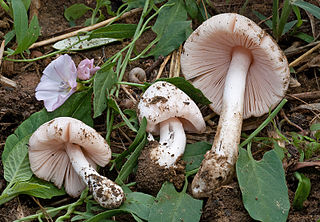
Edible mushrooms are the fleshy fruit bodies of several species of macrofungi. Edibility may be defined by criteria including the absence of poisonous effects on humans and desirable taste and aroma. Mushrooms that have a particularly desirable taste are described as "choice". Edible mushrooms are consumed for their nutritional and culinary value. Mushrooms, especially dried shiitake, are sources of umami flavor.

Volvariella is a genus of mushrooms with deep salmon pink gills and spore prints.

In mycology, a universal veil is a temporary membranous tissue that fully envelops immature fruiting bodies of certain gilled mushrooms. The developing Caesar's mushroom, for example, which may resemble a small white sphere at this point, is protected by this structure. The veil will eventually rupture and disintegrate by the force of the expanding and maturing mushroom, but will usually leave evidence of its former shape with remnants. These remnants include the volva, or cup-like structure at the base of the stipe, and patches or "warts" on top of the cap. This macrofeature is useful in wild mushroom identification because it is an easily observed, taxonomically significant feature. It is a character present among species of basidiomycete fungi belonging to the genera Amanita and Volvariella. This has particular importance due to the disproportionately high number of potentially lethal species contained within the former genus.
Fungiculture is the cultivation of fungi such as mushrooms. Cultivating fungi can yield foods, medicine, construction materials and other products. A mushroom farm is involved in the business of growing fungi.

The Pluteaceae are a family of small to medium-sized mushrooms which have free gill attachment and pink spores. Members of Pluteaceae can be mistaken for members of Entolomataceae, but can be distinguished by the angled spores and attached gills of the Entolomataceae. The four genera in the Pluteaceae comprise the widely distributed Volvariella and Pluteus, the rare Chamaeota, and Volvopluteus, which was newly described in 2011 as a result of molecular analysis. The Dictionary of the Fungi estimates there are 364 species in the family.

Volvariella volvacea is a species of edible mushroom cultivated throughout East and Southeast Asia and used extensively in Asian cuisine. They are often available fresh in regions they are cultivated, but elsewhere are more frequently found canned or dried. Worldwide, straw mushrooms are the third-most-consumed mushroom.

Pluteus is a large genus of fungi with over 300 species. They are wood rotting saprobes with pink spore prints and gills that are free from the stem.

Amanita brunnescens, also known as the brown American star-footed amanita or cleft-footed amanita is a native North American mushroom of the large genus Amanita. It differs from A. phalloides by its fragile volva and tendency to bruise brown.

In mycology, a volva is a cup-like structure at the base of a mushroom that is a remnant of the universal veil, or the remains of the peridium that encloses the immature fruit bodies of gasteroid fungi. This macrofeature is important in wild mushroom identification because it is an easily observed, taxonomically significant feature that frequently signifies a member of Amanitaceae. This has particular importance due to the disproportionately high number of deadly poisonous species contained within that family.

Clitocybe nebularis or Lepista nebularis, commonly known as the clouded agaric, cloudy clitocybe, or cloud funnel, is an abundant gilled fungus which appears both in conifer-dominated forests and broad-leaved woodland in Europe and North America. Appearing in Britain from mid to late autumn, it is edible, but may cause gastrointestinal issues.
Peter Darbishire Orton was an English mycologist, specialising in agarics.
Derek Agutter Reid was an English mycologist.

Volvopluteus is a genus of small to medium-sized or big saprotrophic mushrooms growing worldwide. The genus has been segregated from Volvariella with which it shares some morphological characteristics such as the presence of a volva and a pink to pink-brown spore print. Phylogenetic analyses of DNA data have shown that Volvopluteus is closely related to Pluteus and both genera currently are classified in the family Pluteaceae, while Volvariella is not closely related to either genus and its position in the Agaricales is still uncertain.

Volvopluteus gloiocephalus, commonly known as the big sheath mushroom, rose-gilled grisette, or stubble rosegill, is a species of mushroom in the family Pluteaceae. For most of the 20th century it has been known under the names Volvariella gloiocephala or Volvariella speciosa, but recent molecular studies have placed it as the type species of the genus Volvopluteus, newly created in 2011. The cap of this mushroom is about 5–15 cm (2–6 in) in diameter, varies from white to grey or grey-brown, and is markedly sticky when fresh. The gills start out as white but they soon turn pink. The stipe is white and has a sack-like volva at the base. Microscopical features and DNA sequence data are of great importance for separating V. gloiocephalus from related species. V. gloiocephalus is a saprotrophic fungus that grows on grassy fields and accumulations of organic matter like compost or woodchips piles. It has been reported from all continents except Antarctica.

Volvariella surrecta, commonly known as the piggyback rosegill, is an agaric fungus in the family Pluteaceae. Although rare, the species is widely distributed, having been reported from Asia, North America, Northern Africa, Europe, and New Zealand. The fungus grows as a parasite on the fruit bodies of other gilled mushrooms, usually Clitocybe nebularis. V. surrecta mushrooms have white or greyish silky-hairy caps up to 8 cm (3.1 in) in diameter, and white gills that turns pink in maturity. The stipe, also white, is up to 9 cm (3.5 in) long, and has a sack-like volva at its base.

Volvariella bombycina, commonly known as the silky volvariella, silky sheath, silky rosegill, silver-silk straw mushroom, or tree mushroom, is a species of edible mushroom in the family Pluteaceae. It is an uncommon but widespread species, having been reported from Asia, Australia, the Caribbean, Europe, and North America. The fruit body (mushroom) begins developing in a thin, egg-like sac. This ruptures and the stem expands quickly, leaving the sac at the base of the stem as a volva. The cap, which can attain a diameter of up to 20 centimetres, is white to slightly yellowish and covered with silky hairs. On the underside of the cap are closely spaced gills, free from attachment to the stem, and initially white before turning pink as the spores mature. The mushroom grows singly or in clusters, often appearing in old knotholes and wounds in elms and maples. V. bombycina contains compounds with antibacterial properties.

Volvopluteus earlei is a species of mushroom in the family Pluteaceae. It was originally described in 1911 by American mycologist William Alphonso Murrill as Volvariopsis earlei, based on collections made in a Cuban banana field. The fungus was later shuffled to the genera Volvaria and Volvariella before molecular studies placed it in Volvopluteus, a genus newly described in 2011.
Volvariella leucocalix is a species of fungus in the family Pluteaceae. Its name is attributed to the white volva pertaining to the species. More specifically, the name comes from the Greek words, ‘leuco’, meaning a whitish color, and ‘calix’, meaning cup. First described by Sa MCA and Felipe Wartchow in 2016 as a species of Volvariella.

Volvariella pusilla, is a species of agaric fungus in the family Pluteaceae, described by Rolf Singer in 1951.















